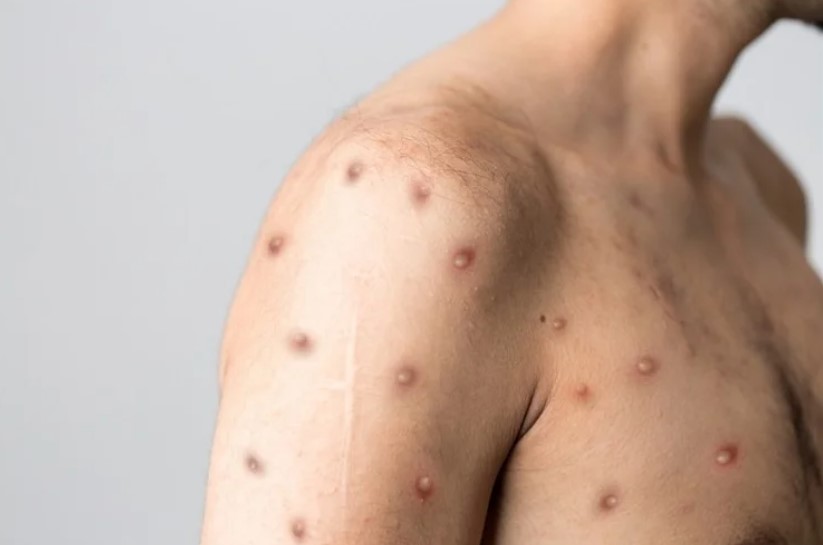
The infectious disease known as monkeypox, caused by the monkeypox virus, is a serious condition that can result in symptoms such as fever, painful rash, and enlarged lymph nodes. While some people recover completely from monkeypox, others may experience severe illness. Anyone can contract monkeypox, including those who come into contact with infected people, animals, or contaminated materials such as sheets, clothes, or needles. Additionally, pregnant individuals who are infected with monkeypox can pass the virus to their unborn baby.
It is important for those who are infected with monkeypox to inform anyone they have been in close contact with recently, to stay at home until all scabs have fallen off and a new layer of skin has formed, to cover their lesions, wear a well-fitting mask when around other people, and to avoid physical contact. Monkeypox is caused by an enveloped double-stranded DNA virus of the Orthopoxvirus genus in the Poxviridae family, which includes other viruses such as variola, cowpox, and vaccinia. The virus has two genetic clades: clades I and II.
The virus was first discovered in Denmark in 1958 in monkeys used for research, and the first reported human case occurred in 1970 in the Democratic Republic of the Congo. Monkeypox can spread from person to person or from animals to people. Following the eradication of smallpox in 1980 and the end of smallpox vaccination worldwide, monkeypox has steadily emerged in central, east, and west Africa. In fact, a global outbreak of monkeypox occurred in 2022-2023. While various small mammals such as squirrels and monkeys are susceptible, the natural reservoir of the virus is unknown.
Transmission of monkeypox can occur through direct contact with infectious skin or other lesions such as in the mouth or on genitals. This includes face-to-face contact, skin-to-skin contact, mouth-to-mouth contact, and mouth-to-skin contact. The virus can also enter the body through broken skin, mucosal surfaces such as oral, pharyngeal, ocular, genital, and anorectal, or via the respiratory tract. Additionally, people can contract monkeypox from contaminated objects such as clothing or linens, through sharps injuries in healthcare, or in community settings such as tattoo parlors.
Symptoms of monkeypox typically begin within a week but can start 1-21 days after exposure. Common symptoms include fever, sore throat, headache, muscle aches, back pain, low energy, swollen lymph nodes, and a rash. While the rash typically lasts 2-4 weeks, it can last longer in individuals with weakened immune systems. The rash begins as a flat sore which then develops into a blister filled with liquid that may be itchy or painful. As the rash heals, the lesions dry up, crust over, and fall off. Some individuals may have one or a few skin lesions while others have hundreds or more. Lesions can appear anywhere on the body, including the palms of hands and soles of feet, face, mouth and throat, groin and genital areas, and anus.
Complications from monkeypox can occur, especially in children, pregnant individuals, and those with weakened immune systems. For example, skin infections can occur leading to abscesses or serious skin damage. Other complications include pneumonia, corneal infection with loss of vision, pain or difficulty swallowing, vomiting and diarrhea causing severe dehydration or malnutrition, sepsis, inflammation of the brain (encephalitis), or inflammation of the heart. While some people can be infected without developing any symptoms, monkeypox can cause severe illness and it is important for individuals to take precautions to protect themselves from the virus. Some ways to prevent the spread of monkeypox include:
- Practice good hygiene: Wash your hands frequently with soap and water or use an alcohol-based hand sanitizer. Avoid touching your face, especially your eyes, nose, and mouth.
- Avoid contact with infected animals: Do not handle, touch, or eat wild animals, especially rodents, monkeys, and squirrels. If you must handle these animals, wear gloves and protective clothing.
- Avoid contact with infected humans: Avoid close contact with individuals who have been diagnosed with monkeypox or who are exhibiting symptoms of the virus.
- Wear protective clothing: If you work with animals or in areas where monkeypox is present, wear protective clothing such as gloves, gowns, masks, and eye protection.
- Get vaccinated: The smallpox vaccine has been found to provide some protection against monkeypox. Speak to your doctor to see if the vaccine is recommended for you.
If you think you have been exposed to monkeypox, seek medical attention immediately. Symptoms of monkeypox may include fever, headache, muscle aches, backache, swollen lymph nodes, chills, and exhaustion. A rash then develops, often beginning on the face then spreading to other parts of the body.
Prompt medical attention is important, as monkeypox can be a serious illness that may require hospitalization. While there is no specific treatment for monkeypox, supportive care, such as pain relief and hydration, can help manage symptoms.


